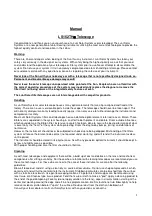
10
the red dot.
If not:
Without moving the telescope, use the EZ Finder’s left/right (azimuth) and
up/down (altitude) adjustment knobs to position the red dot on the object in the eyepiece. If the red
dot is centered on the object in the eyepiece, you’re done!
The finder scope has a battery pack attached to the telescope. To change batteries, just slide the
cover off the pack, and replace the two AA (or AAA) batteries. At the end of your observing
session, be sure to turn the power knob counterclockwise until it clicks off.
What to Expect
Depending upon what is in the sky; Planets will look small, but you might be able to see cloud
bands on Jupiter, some of its moons and the rings of Saturn. Craters on the Moon will be clear and
numerous, the waxing and waning of Venus should be visible, and many bright deep-sky objects
will fill the eyepiece. Don’t expect to see color as you do in NASA photos as our eyes are not
sensitive enough to see color in deep-sky objects, except in a few of the brightest ones. Remember
that you are seeing these objects using your own eyes, the photons having traveled great distance to
register on your eyes and be witnessed by you! Each session with your telescope will be a learning
experience. Each time you work with the telescope, it will get easier to use, and stellar objects will
become easier to find.



























